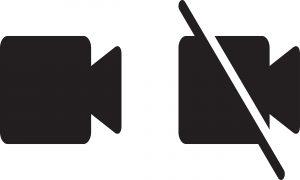Earlier this year, when many of us began working remotely 100 percent of the time and Zoom became a household word that could be used as a noun and a verb, I found out the hard way just how much some people don’t like the fact I don’t – as a rule – use a webcam when I attend virtual meetings. It’s not that I don’t have access to one or more webcams, I do. I just don’t have them on certain devices that I use daily. That’s by design, just like how I have webcam covers on the integrated cameras on my laptops, and how my preference is to opt out of apps that want access to the cameras on my smartphones even when it’s unnecessary, meaning that access isn’t tied to app functionality.
In short, I use webcams when I must but I’m not a big fan.

Are they handy? Yes, especially when we want to connect with our loved ones, or we need to have a one-on-one with someone to discuss something that we would normally handle in person but can’t. They’re especially handy for those creating YouTube content with their phones. Okay, maybe those aren’t specifically webcams, but where would we be without Finnegan Fox saying “Hehehehe”?

Are they necessary if you are a panelist at a virtual conference or trying to land a big contract? Yes, because attendees want to associate a name with a face and presentation fatigue is real. Just think of the last time you were in a meeting and a slide deck filled with bullet points appeared on your display because someone did a screen share. Did you groan? Maybe you didn’t with that presentation, but I would suspect you’re guilty of at least one eye roll in the last six months. Maybe when the slide deck broke the 5/5/5 or the 10/20/30 rule? Or when you realized every element in the first slide was animated? Your mic was muted, and your webcam wasn’t enabled, right?

Do they sometimes reveal far more than they should? Yes, they do, especially when users think they are offline, and they aren’t. When that happens, the lessons are difficult and public.
Are webcams secure?
Well, that’s a matter of opinion, and goes to the heart of why I’m not a big fan and why I tend to err on the side of their use not being mandatory. Yes, the data can be secure if the platform you are using to conduct a virtual meeting uses end-to-end encryption, but not all platforms do and some, like Zoom which just recently introduced end-to-end encryption, require account owners and admins to enable the feature.
Even with end-to-end encryption, however, a webcam is only going to be as secure as the computing device that’s being used to access it. If an end user has clicked Remind Me Later on update notices for months, or the device is infected with malware, then that device, and the webcam, are vulnerable. Did you know there’s even a term for when a hacker gains access to a camera on a device and is able to see everything in its field of vision? It’s called camfecting.

Do webcams sometimes reveal far more than they should (think security)? Yes, they do, and that can be cause for concern. Not everyone takes the approach of one of my colleagues, who is always positioned in front of a white wall. I’ll try not to scare you but those who have an interest in security will understand when I say a picture is worth a thousand words. Backgrounds that aren’t austere can reveal a lot about a person…the type of router they own, where they live, and their family and friends.
It’s this last point, that can be extremely problematic. For some, the necessity of using a webcam can reveal so much that it can put them at risk of physical harm. Using a device to log into a virtual meeting, for example, could reveal the location of a victim to an abuser or a stalker.

Of course, not using webcams can be an issue, too. We’re living through a pandemic, and many want and need to see other people; virtual meetings (and webcams) may offer the only opportunity for human interaction or to say goodbye. Criminals have been caught in the act, and lives have been saved, thanks to webcams and vigilant teachers and others who saw something and said something. Then there’s the issue of accessibility. The American Speech-Language-Hearing Association recommends the use of video in virtual meetings and suggests participants be encouraged to use webcams because “visual cues help people with and without hearing loss understand conversations.”

